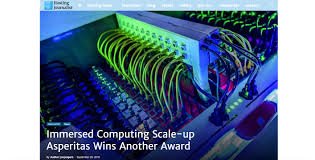Rival data center liquid cooling vendors GRC (Green Revolution Cooling) and Asperitas have launched a joint site to promote immersion cooling.
The Immersion Cooling Facts site sets out the benefits of immersion cooling, while dispelling "myths" about the technology, the companies said.
Rolf Brink and Peter Poulin, CEOs of Asperitas and GRC respectively, explained the site in a video interview at DCD>London on 6 November. As well as listing benefits that data center operators might miss, the site explores new opportunities such as Edge, and distinguishes between different immersion cooling methods.
Fluid thinking
"We are two competitors, and unlikely collaborators who have come together with the sole purpose of separating fact from fiction in order to ensure a healthy, high quality, and reliable immersion industry," says the site.
At DCD>London, the two expanded on this: "We’ve been seeing a lot of traction in the market for immersion cooling," said Brink.
"But something happened in the last couple of years, where a distraction resulted in more immersion companies popping up, but more misinformation. Since we all need to be able to grow and the market needs to be able to grow, we want to make sure that all the immersion technologies out there will be able to work with the same information, so wrong information doesn’t get out there."
Despite being competitors, the two companies were already collaborating on white papers and standards in the Open Compute Project (OCP), along with other immersion cooling rivals Zutacore and Submer. As Poulin describes it, GRC and Asperitas found that their answers to a list of key questions matched: "We were confident that we had information we could share with the market that was accurate and consistent."
Two-phase
Some liquid cooling systems rely on "two-phase" operation, where the cooling fluid is allowed to boil, and then condense. In theory, this can remove heat rapidly because it uses the latent heat of vaporization, as well as the heat capacity of the fluid. In practice, the boiling process creates more mechanical strain on the system, so in many cases single-phase operation (as offered by the two partners) is preferable, the companies said.
The two vendors believe that the distinction between single-phase and two-phase immersion cooling is often lost on the public: "People talk about immersion with a single stroke, and don’t differentiate between single-phase and two-phase," said Poulin, and single-phase cooling vendors get lumbered with the negative baggage associated with two-phase technologies.
"That’s part of what we do in educating the market," said Poulin. "It's Immersion 101 questions. You’ve really got to understand the science."
While many people see power density as a reason for moving to liquid cooling, the technology has other benefits, the two say. If a data center is short of electrical power, then moving to liquid cooling reduces the power demands of conventional air cooling systems: "By converting to liquid cooling they free up a bunch of power that they were using for cooling, and that can go towards compute," said Poulin.
In space-constrained markets, liquid cooling takes up less floor area, and in Edge locations, liquid cooling provides the benefit of doing away with the need for specialized white space with a raised floor, that is only available in purpose-built data centers.
Looking around the DCD event, Brink said: "At an event like this, have you ever seen an air-cooled rack fully equipped with servers, actually switched on and running at performance? Of course you haven’t, because you aren’t in a data center. But here at this event today, there are four immersion technologies live and running - in an event that was never designed as a white space.
"You can deploy immersion technology anywhere: you don’t need a data center. It’s great if you have one. But when it comes to edge deployments, this is where the world is changing.
"We don’t think immersion is right for every use case. But we want to make sure customers can make fact-based decisions about which technology is appropriate."

